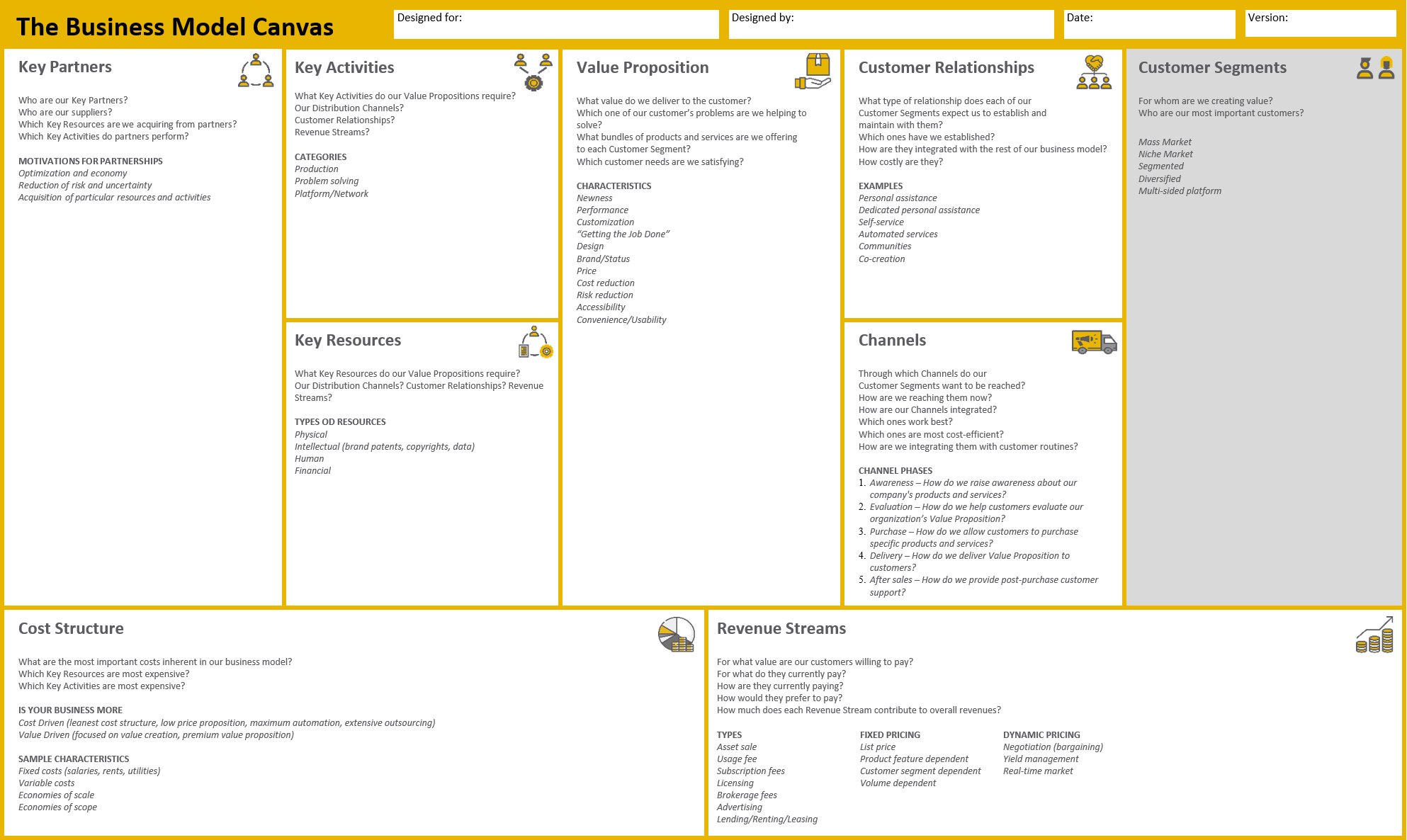Module 2
CUSTOMER SEGMENTS
The purpose of this module is to help you understand what the Customer Segments are and how you can work with this in your business plan.



Customer segments
Introduction
Any organization serves at least one type of Client or Customer Segment. In order to best respond to customers’ needs, it is fundamental to identify them.
-
- For who are the products or services that your organization provides?
- Whose problem is your company aiming to solve?
- Is there any “most important” clients? Who are they?
Purpose
The purpose of this module is to help you understand what the Customer Segments are and how you can work
with this in your business plan.
Learning Outcomes
After the completion of this module the learner will be able to:
-
- Grasp what is a Customer segment is;
- Comprehend the importance of Customer Segments in a business model;
- Illustrate different Customer Segment models;
- Recognize how the different Customer Segments are capable of impacting other parts of the business model.
Keywords
-
- Customer Segments
- Mass Market
- Niche Market
- Segmented
- Diversified
- Multi-sided platforms
- Market studies
- Client perspective
Theoretical background
Customer segments are located on the top right-hand side of the business model canvas.
Goals
- Customers are an essential part of any business, as without them there is no way that a business can survive for long. Businesses aim to thrive and not only to survive. Either way, it is crucial to understand how your organization can serve and satisfy its clients.
- The decision to focus on or to ignore a Customer Segment is a huge decision, with a big impact on the rest of the organization’s business model. For instance, if you choose a market that is too broad, you may not be able to respond to the specific needs of your clients, but if you choose a market that is too narrow, you may not have enough clients to successfully operate a sustainable business. It is relevant to state, however, that this generally depends on the context and on your business model, as some businesses may work well in a mass market, while others may work well in a niche market.
- Since it is often rather difficult, if not impossible, to have very specific knowledge of each and every individual client (unless you are working with a small number of customers), it is important to group your customers into segments, considering similar features, needs or behaviour.
- Different business models can serve one or several client segments, and they can be similar or very different among them.
Segmentation
allows you to:
- Adapt your product to different customer segments, identify improvements and new product opportunities;
- Create target messages to specific customer segments to increase marketing effectiveness;
- Pick the most appropriate channel for each customer segment;
- Nurture better customer relationships;
- Test pricing options;.
- Identify different levels of profitability among customer segments.
All of this allows you to improve customer service, customer satisfaction and to better adapt your business model according to the customer segments.
Only following a correct identification of the Customer Segment can a business respond to the question:
- To WHO are you going to present and serve your value proposition?
A correct customer segmentation is important, because if a mistake is made, and you wrongly identify your business clients or potential clients, you may be gathering information from the wrong source, leading to erroneous conclusions.
After you identify the WHO, you can ask HOW your product is going to provide gain for the client, or how will it reduce their ‘pain’ (inconvenience). You can also ask WHEN and WHERE, to obtain more insight on how to increase and deliver your value proposition.
How to do it
First of all, to segment clients you need information about them, and you may obtain this from purchasing information, that is, from the information about the clients that effect purchases and from the transaction itself.
Clients can be clustered according to:
- their needs and the kind of offer that suits them (i.e., low cost, or premium);
- other considerations about the type of products;
- the distribution channel used (i.e., online, retail, etc.);
- the type of client relationship (transactional relationship vs. personal assistance);
- different profitability (loss, free, low or high).
The segmentation may be done according to very different features, and not only according to the previous elements presented. One of the first type of segmentation that may be considered is whether the client is an individual or another business. After that, further segmentation can be done using :
Business
- Size
- Market
- Location
- Previous products
Customers
- Age
- Gender
- Marital status
- Social status
- Location (urban, suburban, rural)
- Life stage ( teenagers, young adults, mid-life, retired)
Besides purchasing information, another way of gathering information about customers is through market studies.
These studies will provide insights about preferences, accepted price ranges, possible requirements about quality, or sustainability, amongst other information, as well as consumer understanding of the product, behaviour that may indicate needs or better ways to satisfy the needs, and the decision-making process.
To access this information, surveys and focus groups may be used. There are specialized companies that provide this kind of service, which is based on the expertise of social scientists such as Psychologists, Sociologists and Market experts.
Larger companies may even have their own market studies department.
Even if you do not have the possibility right now to hire these professionals or to sub-contract these services, you may design your own approach to the market, reach out to potential clients, talk to them and listen to them.
You may either use purchasing information, market studies, or a more simple way which involves listening to your clients (or to potential clients).
It is very important to collect information about the perspective of the client. Switching the focus from your organizational perspective to that of the client raises a different set of questions, for instance:
| Company perspective | Client perspective |
| How much can we profit from this product? | What is an acceptable price range for this product? |
| What client relationship will we create? | What relationship is expected? |
| What product/ service will we sell? | How can I be helped/ satisfied with this product/service? |
Types
We will now explore different approaches to the Customer Segmentation. This is not a list of segments, but a list of possible forms of dealing with the Customer Segments, namely:
- Mass Market
- Niche Market
- Segmented
- Diversified
- Multi-sided platforms
Mass Market
Business models that are aiming at mass markets do not distinguish between client segments.
They build their business models by considering a large group of persons with the same needs, or problems, regardless of their features, no matter how different these clients may be.
The business of household products is one example of a mass market.
Niche Market
This market approach targets very specific and/or specialized clients, so by definition, they serve a relatively small market. The business model is built around a very specific need so all the blocks are adapted with that in mind, including the value proposition, the channels, and the client relationship.
One example is the niche market for organic food, this is one specific part of the food market.
Segmented
Instead of targeting a mass market or a niche market, some business models identify different segments of their clients, adapting their business model to the needs of the different segments. That said, they may use different channels, client relationships, or a different value proposition with different segments.
Banks, for example, may use different approaches to different clients, considering their assets. Clients with lower assets are part of a bigger group than clients with higher assets, and their necessities differ, so the products and the type of interaction required are adapted by the bank according to these segmentations.
The lens and the image processing industry also serves different clients with different needs. The photo camera is a natural market, but over time, a new natural market emerged, the mobile phone camera. In the mobile phone segment, the importance of the size of the lens and the needs of the image processing may be different. More recent markets, such as assisted driving, present other challenges.
Diversified
The Diversified approach is similar to the Segment mentioned earlier, because it serves more than one segment. At the same time it is different because the segments are not similar. It is not a matter of adapting the value proposition to a slightly different segment, but of adapting it to a completely different one.
Amazon is a good example of this approach. It started off as an e-commerce platform. Later, using their IT platform, Amazon began to offer a cloud computing service, not to mention their streaming service, Amazon Prime, or the artificial intelligence market.
These are just some examples of very diverse client segments and value propositions. Amazon ventured into many other areas, some were more successful than others.
Multi-sided platforms (or multi-sided markets)
Multi-sided or double sided Business Models are models that link two or more different client segments, each of which benefits each other from the connection. This is mainly to facilitate the interaction among segments.
For instance, the video game console business model links the client segment of the game developers and the client segment of the gamers. One cannot live without the other. Without games available for the console, there would be no gamers, and without gamers buying the console, there would be no interest from the game developers.
Examples and Good practice
It is very important to correctly identify the Customer Segments in order to better satisfy the needs of each client segment, to create appropriate relationships, and to create the best match possible.
A better definition of the organization’s Customer Segments and more knowledge about each Customer Segment will allow for a more satisfactory reaction to their expectations or it may even create potential opportunities and synergies.
Here are some examples (in the following slides) on how to use and apply Customer Segments in different Business Model Patterns.
Multi-sided Markets
It is relevant to achieve a comprehensive understanding of the different Customer Segments in order to maintain a good balance among them for your business to thrive. With that knowledge, you may figure out that, for example, each segment is more sensitive to price, and subsequently decide to reduce the price for one of them in order to create a better situation for the other.
Some console companies decided to sell consoles with a loss, in order to attract more game developers and sell more games to the gamers.
An even more extreme example is the free newspaper that is aiming to get the most readers possible to ensure profit through advertising, hence linking the advertisement industry with the readers / consumers. One segment (the readers) is having a free service, these, in turn, attract another profitable segment, the marketing industry, that pays for the advertisements.
Unbundling business
“Unbundling“, in very simple terms, refers to the practice of separating different lines of business. This business model perspective assumes that some businesses have different kinds of businesses bundled, and that it may be better to ‘Unbundle the Business’ in order to better understand the different responses that it should give to different client segments, and the action that may be required.
Some private banks decided to Unbundle, understanding that their clients are in different segments, such as, for example, rich individuals and families searching for wealth management, but also other banks and consultants that use their financial products. They used this technique to help them focus on in these segments and each of their different objectives and needs.
They adjusted their business models, considering the different client segments (one for each client segment), avoiding conflicting objectives and possible trade-offs.
For instance, the objective to sell financial products created by the bank conflicted with the objective to provide better advice to individual clients, even if that meant selling the financial products of other banks.
Airlines
The natural Customer Segment for airlines in the early stages of this industry was the upper class, due to the high cost of air travel. This defined the value proposition together with the services offered among all the other component parts of the business model.
With the evolution of technology for air travel, such as the use of jet engines, among others, the costs of flying dropped. That lead to the possibility of reaching different Customer Segments, making even more sense of the use of different facilities for different Customer Segments in air travel, such as First Class and Economy Class. Moving further along in time, the advent of low cost airline companies democratized air travel even more. These companies focused on reducing the cost (by eliminating non-essential services or ‘frills’) in order to offer the lowest price possible in order to reach even more customers.
The success achieved by low cost no-frills airlines lead to traditional air companies also offering low cost options to their customers.
In these examples, revisions in the Business Models allowed the companies to reach out to different client segments. The consideration of different client segments provoked changes in the value propositions and in client relationships.
In some cases, new brands were created in order to make a clear division between the offers to different Customer Segments, such as “Go Fly”, British Airways low cost subsidiary. Even within the same brand it is fairly common nowadays to have different levels of offers for the same flight.
Restaurants
After paying attention to their clients, a particular restaurant realized that they could be segmented into clients that bought food to take away and clients that would sit and eat at the restaurant. This simple insight lead to different solutions, such as creating two entry points in the same space, increasing the facility of access and speed for the take away options, and increasing the comfort and using a more personal experience for the other clients who sat and ate in the restaurant.
References and External Links
- Osterwalder, A., Pigneur, Y., In Clark, T., & Smith, A. (2010). Business model generation: A handbook for visionaries, game changers, and challengers.
- https://strategyzer.uservoice.com/knowledgebase/articles/1194379-how-do-i-use-the-customer-segments-building-block
- https://www.shopify.com/encyclopedia/customer-segmentation
- https://www.youtube.com/watch?v=m2IPvT920XM
Copyright @2021 – businessmodels.eu


